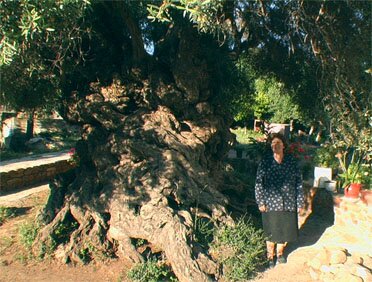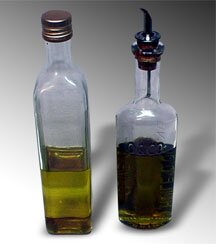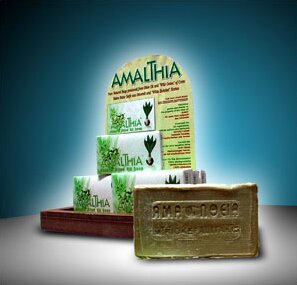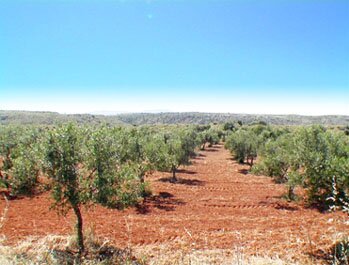
| Olive Oil | |||
| ・ History of Olives | |||
|
・ Olive Oil and Its Color |
|||
| ・ Acidity of Olive Oil | |||
| ・ Practical Advice on Choosing Olive Oil | |||
| ・ Organic Olive Oil | |||
| ・ Olive Oil in maintaining Good Health | |||
| ・ How to Make Your Own Table Olives | |||
| ・ Olive Oil Soap - Amalthia | |||
| History of Olives |
 |
||
|
The olive tree, indigenous to the Mediterraneanarea, |
|||
|
Archaeologists who carried out excavations on Crete, in the area of Zakros on the east side of the island, have uncovered |
|||
|
|
|||
 |
Olive Oil and Its Color | ||
|
Green Colored Olive Oil: |
|||
| Golden-Yellow Olive Oil: This probably comes from olives that had started to turn reddish or black. It generally has a milder taste, more fruity and gives off a variety of aromas. The smell may be reminiscent of fruit or vanilla. This is the oil usually chosen by chefs especially when cooking fish. But all these points are matters of personal choice. Good extra virgin olive oil can be used for many purposes, even for sweets or cakes. In traditional Greek cooking, only olive oil is used for this baking and the oil is generally of a very high standard. |
|||
| Acidity of Olive Oil |  |
||
|
The degree of acidity in olive oil |
|||
|
・Acidity 0.1-1.0 Extra Virgin Olive Oil |
|||
| Practical Advice on Choosing Olive Oil |
||
| Good olive oil has a pleasant taste and smell. In general, virgin olive oil extra should always be chosen. If the level of acidity is mentioned, make sure it is low. International agreement states that extra virgin olive should have an acidity level between 0.1 and 1. Recently, some bottles have included exact information regarding this matter (i.e. 0.5 or 0.8). This is a good sign which gives the consumer the choice of a high quality oil or a poor, blended olive oil. |
|
|
Organic Olive Oil
|
||
| Recent Greek olive oil producers provide an oil which is rich in organic characteristics. Olive oil extraction is done under strict conditions of processing, where only mechanical pressing is permitted with no heat in the press nor other techniques which might affect its characteristics. In countries of the European Union (including Greece, of course), organic products are strongly protected by law and are carefully checked by quality control organizations. |
|||
| Olive Oil in maintaining Good Health | ||
| The study of the Seven Countries, which was organized by Anzel Keys towards the end of the 1950s greatly surprised the international scientific community. The Cretans, whose food floated in oil, were found to have the best health in the world. Cancerous diseases were rare, in fact much less frequent than all the areas studied and perhaps in all the world, and cardiovascular diseases were almost unknown on Crete. |
| How to Make Your Own Table Olives | ||
| If you can find black olives of the Kalamata variety, try this traditional Greek recipe. These olive fruits are large and are gathered when they are deep black but before they are wrinkled. Select firm and unbruised olives. Incise the olives lengthwise in two places with a sharp knife without touching the stone. Place them into a large clay or plastic vase with enough water to cover them for about 12 days changing the water daily until they are no longer bitter. Prepare brine with 1 litre water and 100 grams salt for every kilo of olives, put the sweetened olives in the brine and leave them for two days. Then drain them and soak in vinegar where you have added a little water (4 parts of vinegar to 1 part of water) for another two days. Finally drain them again and store in glass or clay jars covered with olive oil. Season with bay leaves or oregano, if desired. |
||
| Olive Oil Soap - Amalthia |  |
||
| Soap is regarded today, even after the tremendous expansion of synthetic detergents, as the perfect cleaning product. This is due to the fact that it is not toxic, acts effectively when used with soft water and doesn't pollute the environment. Natural green olive oil soap is produced from residue oil of high acidity while white soap is produced from pure olive oil. Among all the olive oil soaps that are being distributed in the market today, one should take a careful look at the 100% natural handmade olive oil soap developed by Mr. Vassilis Myriokefalitakis, a goldsmith in Rethymno, Crete. By carefully planning the perfect mix of olive oil taken from his olive tree plantation along with wild onions and fresh herbs (all organic products), he successfully discovered a pure natural soap that can be used for all purposes. Originally, one would wonder why a certain soap is used to cleanse one's body, while another kind is used for shampoo, another one for facial cleansing, etc. If a certain kind of shampoo is too harsh to wash one's face, wouldn't it damage the hair as well? |
|||
| The soap created by Mr. Myriokefalitakis, AMALTHIA, has a unique diversity in that its use is not limited to a certain body part. Surprisingly, it can be used to clean one's face, as well as hair, body, shaving cream, and any other parts that require cleansing. Findings have shown its amazing effect such as prevention against hair loss, cure of skin rash, dandruff, dry skin and other dermatological diseases. A good example that vividly shows Amalthia's effects was conducted where two tomato trees were planted in a vase with a mixture of water and Amalthia and another one in a mixture of water and baby soap (soap that is said to be the most delicate). As one would expect, the tomato tree planted in the baby soap mixture died out in a couple of days, while the one in the Amalthia mixture lasted to the extent that tomatoes grew on the tree and they were perfectly edible. This biodegradable soap does NOT contain any artificial color or perfume, and will return to the ground as a natural fertilizer. Amalthia today is exported to Germany, England, the United States, Cyprus and here in Japan. Please contact [email protected] if you need any more information or interested in purchasing the product. |
|||
